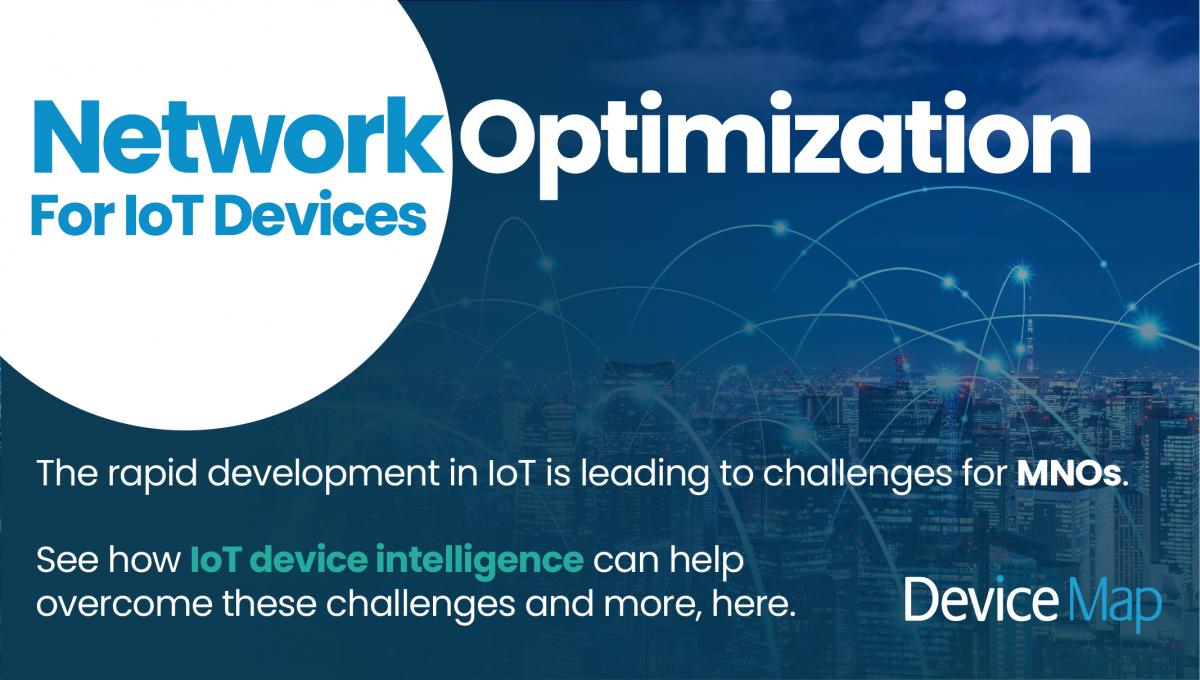
The internet of things (IoT) is developing at a rapid pace. Gartner forecasts that, in the enterprise and automotive IoT market, there will be 5.8 billion IoT endpoints in use by the end of 2020. This represents a 21% increase from 2019, which was already up 21.5% compared to 2018.
Additionally, Statista notes that there will be an estimated 50 billion IoT connected devices in use around the world by 2030.
The vast number of devices and rapid adoption rate demonstrates that businesses are increasingly leveraging the opportunities enabled by IoT. This is resulting in increased challenges for network operators and service providers.
Network Optimization Challenge
With the rate of growth and diversity of connected devices, the challenge for operators is to understand the implications for their networks to help ensure optimal performance. Operators need deeper insight into the nature and capabilities of the terminals (e.g. cameras, data collection terminals, wireless hotspots, etc.).
Many of the new classes of terminal have very different behaviours on the network compared with the traditional voice and data capable cell phone. As a result, operators need to be able to reliably segment traffic to understand the patterns and trends of network usage. This is important for many reasons, including overcoming the following specific challenges.
Example problems that need to be solved:
- Capacity has to be reserved at a cell tower level for IoT devices. Operators must be able to measure IoT activity levels on a per-cell basis, to assess whether the capacity reservations are optimal, as both under-reserving and over-reserving cause inefficiencies;
- Rate plan misuse. Since different data rate plans are provided for IoT devices and consumer devices, the operator needs to be able to monitor whether the device in use is aligned with the plan; and
- Limited understanding of device capabilities on a network. Limited insight into subscriber device capabilities, and their changes over time, makes planning network enhancements, to meet demand, more difficult.
Enabling Network Optimization With Enriched Device Intelligence
Device Map, developed in partnership with the GSMA, is the authoritative source of device intelligence for the mobile ecosystem.
Device Map combines the GSMA issued TAC with detailed device capabilities to deliver rich IoT and non-IoT device insights, that enable mobile network operators and related service providers to make more informed business decisions.
IoT Device Intelligence
As mentioned, operators need deeper insight into the nature and capabilities of terminals. Device Map provides this.
There are now over 20 device classifications in Device Map, providing full granularity into diverse traffic sources such as geolocation trackers, embedded network modules, digital home assistants, meter hubs and security hubs, along with the above-stated cameras, data collection terminals, and wireless hotspots.
Additionally, Device Map includes a set of properties to classify IoT devices. These property details are as follows:
Property Name |
Property Description |
Example |
IoT Endpoint |
Sensor and/or actuator, with cellular connectivity |
Camera, Data Collection Terminal, Geolocation tracker |
IoT Enabler |
Provides cellular connectivity to otherwise unconnected devices |
Embedded network module, Modem |
IoT Controller |
Data receiver and aggregator, command/control of remote and/or local IoT devices |
Digital home assistant |
To further support the optimization of networks for IoT devices, Device Map also includes the following protocol properties:
Property Name |
Property Description |
NB-IoT |
The device is capable of connecting to the specific type of narrow-band Low Power Wide Area Network (LPWAN) using radio technology standard specified in 3GPP Release 13. |
LTE-M |
The device is capable of machine-to-machine communication through connecting to the specific type of Low Power Wide Area Network (LPWAN) using radio technology standard specified in 3GPP Release 13. |
NB-IoT and LTE-M are communication protocols designed to support IoT applications. Their lower data bandwidth and low power consumption are more appropriate for IoT applications. NB-IoT tends to be used for very low data volume applications, such as simple sensors that may make hourly or daily updates. Whereas, LTE-M supports larger data volumes, appropriate for continuous monitoring or surveillance.
To leverage and enable IoT opportunities, operators need to make NB-IoT and/or LTE-M support decisions. Many factors can impact support decisions, such as if an operator already has LTE networks - LTE-M may be lower cost to roll out, but is less efficient for very low data volume applications. Additionally, device capabilities on a network (specifically, the level of devices that are NB-IoT and LTE-M capable) and the change over time are considerable factors.
Device Map enables operators to understand whether devices on their network support these technologies, which can have significant benefits.
Benefits Of These Properties
Operators and relevant service providers can leverage the above Device Map properties to overcome many network optimization challenges. Specific benefits of the properties include:
- Simplified analysis and comparison of traffic types, to permit accurate capacity allocation in the network;
- Facilitates measurement of trends of IoT traffic, including levels of rate plan misuse;
- Understand whether devices on a network support specific technologies and, based on the scale and trends, plan network enhancements accordingly; and
- Permits distinguishing between traffic which is 100% IoT (IoT Endpoints) and traffic which may represent a mix of IoT and non-IoT traffic (IoT Enablers).
Distinguish Between Consumer Devices And M2M Devices
Consumer behaviour on a network is very different to IoT device behaviour. Therefore, how operators choose to optimize their networks for each type of behaviour will likely differ.
For cases where the operator need is to distinguish between consumer devices and M2M devices, additional Device Map properties can be leveraged. Specifically, “Primary Hardware Type” can be used. Examples of Primary Hardware Type include device types such as Mobile Phone, Desktop and Games Console–typically used by consumers–in addition to Data Collection Terminal and Embedded Network Module–common in M2M systems.
Learn more about Device Map, its properties and get a data sample, here.



